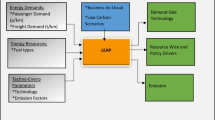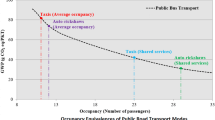Abstract
Purpose
As one of largest energy consumers, the transport sector (TS) has significant impacts on the environment. Shenzhen, a developed megacity in South China, plays a leadership role in promoting the development of energy efficient vehicles in China.
Methods
This paper aims to assess the carbon footprint (CF) of the TS in Shenzhen via a Streamlined Life Cycle Assessment method. Consequently, the current environmental performance of the TS is evaluated and improvement potentials are examined.
Results and discussion
The results show that CF has gained rapid growth over the past decade at an annual rate of 15.3 %, closely corresponding with the growth of the Gross Domestic Product (18.9 %) in Shenzhen. The total CF in 2013 was estimated as 50.7 million tons (ranging from 41.7 to 59.9). Road based freight transport accounts for the largest share of the TS’ emissions. The most significant contributors in this sector are: light duty trucks, urban public transport bus service, and passenger air transport. Meanwhile, this study took new energy vehicles into consideration in order to explore the range of CF mitigation potential in Shenzhen. The potential carbon abatement is not significant in comparison with the impact growth derived from the increasing freight and passenger transport based on the assumption that the transport intensity and its annual growth rate maintain at the current levels.
Conclusions
This study offers a useful approach to evaluate the available options for sustainable transport system planning in Shenzhen. For carbon emissions reductions from the TS, policies and technological innovations are essential to facilitate the transition to a low carbon TS. In addition, the methodology developed in this study could be used for assessing CF in other sectors.







Similar content being viewed by others
References
Andersen NJH, Brandstrup J (2008) Monte Carlo Simulation in Crystal Ball 7.3. Aarhus University, May 2008
APT (2015) Chinese airline completes cooking oil fuel flight. The Express Tribune News Network. Available at: http://tribune.com.pk/story/856836/chinese-airline-completes-cooking-oil-fuel-flight/ (March 21, 2015)
Bauer C, Hofer J, Althaus HJ, Del Duce A, Simons A (2015) The environmental performance of current and future passenger vehicles: life cycle assessment based on a novel scenario analysis framework. Appl Energ 157:871–883
Bhat A, Kumar A (2008) Application of the Crystal Ball® software for uncertainty and sensitivity analyses for predicted concentration and risk levels. Environ Prog 27:289–294
Bi Z, Song L, De Kleine R, Mi CC, Keoleian GA (2015) Plug-in vs. wireless charging: life cycle energy and greenhouse gas emissions for an electric bus system. Appl Energ 146:11–19
Bockarjova M, Steg L (2014) Can protection motivation theory predict pro-environmental behavior? Explaining the adoption of electric vehicles in the Netherlands. Global Environ Chang 28:276–288
Chambers S (2012) China: Shenzhen stands out as pioneering EV city. EV Infrastructure. Available at: http://analysis.evupdate.com/ev-infrastructure/china-shenzhen-stands-out-pioneering-ev-city (May 11, 2012)
Cristea A, Hummels D, Puzzello L, Avetisyan M (2011) Trade and the greenhouse gas emissions from international freight transport. University of Oregon, Purdue University and NBER, Monash University, University of Southern California
CTCS (2014) Year Book of China Transportation & Communications (2013). China Transportation and Communications Society (CTCS), Beijing
Dennis (2013) Few LNG stations in Shenzhen, few LNG trucks. Available at: http://www.chinatrucks.com/news/2013/0709/article_4677.html
Duan H, Hu M, Zhang Y, Wang J, Jiang W, Huang Q, Li J (2015) Quantification of carbon emissions of the transport service sector in China by using streamlined life cycle assessment. J Clean Prod 95:109–116
Frischknecht R, Jungbluth N, Althaus HJ, Doka G, Heck T, Hellweg S, Hischier R, Nemecek T, Rebitzer G, Spielmann M, Wernet G (2007) Overview and methodology: ecoinvent report no. 1. Swiss Centre for Life Cycle Inventories, Dübendorf
Geng Y, Ma Z, Xue B, Ren W, Liu Z, Fujita T (2013) Co-benefit evaluation for urban public transportation sector—a case of Shenyang, China. J Clean Prod 58:82–91
Gomes J, Nascimento J, Rodrigues H (2008) Estimating local greenhouse gas emissions - a case study on a Portuguese municipality. Int J Greenh Gas Con 2:130–135
Gonzalez AG, Herrador MA, Asuero A (2005) Uncertainty evaluation from Monte-Carlo simulations by using crystal-ball software. Accred Qual Assur 10:324–324
Greene DL, Howard H, Baker J, lotkin SEP (2011) Reducing greenhouse gas emission from US transportation. Pew Center on Global Climate Change, Arlington, VA
Guneralp B, Seto KC (2008) Environmental impacts of urban growth from an integrated dynamic perspective: a case study of Shenzhen, South China. Global Environ Chang 18:720–735
Hao H, Wang H, Song L, Li X, Ouyang M (2010) Energy consumption and GHG emissions of GTL fuel by LCA: results from eight demonstration transit buses in Beijing. Appl Energ 87:3212–3217
Hao H, Wang H, Ouyang M (2012) Fuel consumption and life cycle GHG emissions by China’s on-road trucks: future trends through 2050 and evaluation of mitigation measures. Energ Policy 43:244–251
IATA (2009) The IATA technology roadmap report. International Air Transport Association, Switzerland
IEA (2010) CO2 emissions from fuel combustion 2010. International Energy Agency (IEA), OECD/IEA, Paris
IEA (2012) Oil & gas security: emergency response of IEA countries (China). International Energy Agency (IEA), Paris
IPCC (2014) Climate change 2014: mitigation of climate change. In: Edenhofer O, Pichs-Madruga R, Sokona Y, Farahani E, Kadner S, Seyboth K, Adler A, Baum I, Brunner S, Eickemeier P, Kriemann B, Savolainen J, Schlömer S, von Stechow C, Zwickel T, Minx JC (eds) Contribution of working group III to the fifth assessment. Report of the Intergovernmental Panel on Climate Change. Cambridge University Press, Cambridge and New York
ITF (2010) Transport greenhouse gas emissions 2010. ITF/OECD. International Transport Forum (ITF), Paris
Kagawa S, Hubacek K, Nansai K, Kataoka M, Managi S, Suh S, Kudoh Y (2013) Better cars or older cars?: assessing CO2 emission reduction potential of passenger vehicle replacement programs. Global Environ Chang 23:1807–1818
Laurent A, Olsen SI, Hauschild M (2012) Limitations of carbon footprint as indicator of environmental sustainability. Environ Sci Technol 46:4100–4108
Lewis AM, Kelly JC, Keoleian GA (2014) Vehicle lightweighting vs. electrification: life cycle energy and GHG emissions results for diverse powertrain vehicles. Appl Energ 126:13–20
Li H, Lu Y, Zhang J, Wang T (2013) Trends in road freight transportation carbon dioxide emissions and policies in China. Energ Policy 57:99–106
Lipman T (2011) An overview of hydrogen production and storage systems with renewable hydrogen case studies. Prepared for Clean Energy States Alliance. http://www.cesa.org/assets/2011-Files/Hydrogen-and-Fuel-Cells/CESA-Lipman-H2-prod-storage-050311.pdf
Liu Y, Wang Y, Huo H (2013) Temporal and spatial variations in on-road energy use and CO2 emissions in China, 1978-2008. Energ Policy 61:544–550
Loo B, Li L (2012) Carbon dioxide emissions from passenger transport in China since 1949: implications for developing sustainable transport. Energ Policy 50:464–476
McKinnon A (2008) CO2 emissions from freight transport: an analysis of UK data. Logistics Research Centre, Heriot-Watt University, Edinburgh
NBSC (2014) Yearbook of China Statistics (1995–2013). National Bureau of Statistics of China (NBSC), Beijing
Olivetti E, Duan H, Kirchain R (2013a) Exploration of carbon footprint of electrical products: guidance document for product attribute to impact algorithm methodology. A publication of the Materials Systems Laboratory. Massachusetts Institute of Technology, Cambridge
Olivetti E, Patanavanich S, Kirchain R (2013b) Exploring the viability of probabilistic under-specification to streamline life cycle assessment. Environ Sci Technol 47:5208–5216
Ou X, Zhang X, Chang S (2010) Scenario analysis on alternative fuel/vehicle for China’s future road transport: life-cycle energy demand and GHG emissions. Energ Policy 38:3943–3956
Pedersen WB, Wesnaes MS (1996) Data quality management for life cycle inventories—an example of using data quality indicators. J Clean Prod 4:167–174
Quack D, Griebhammer R, Teufel J (2012) Requirements on consumer information about product carbon footprint. Öko-Institut E.V, Freiburg
Regmi MB, Hanaoka S (2010) A Framework to evaluate CF from freight transport and policies to reduce CO2 emissions though mode shift in Asia. 3rd International Conference on Transportation and Logistics (T-LOG 2010), Sep. 2010
Rodrigue JP (2013) Geographical impacts of the Suez and Panama canals. The Geography of Transport Systems, New York: Routledge, p. 416
SBS (2014) Yearbook of Shenzhen Statistics (2004–2014). Statistics Bureau of Shenzhen (SBS), Shenzhen
TCSM (2014a) Year book of transportation & communications in Shenzhen (2004–2013). Transport Commission of Shenzhen Municipality (TCSM), Shenzhen
TCSM (2014b) Sector yearly statistic bulletin of transportation and communications (2004–2014). Transport Commission of Shenzhen Municipality (TCSM), Shenzhen
Tian Y, Zhu Q, Lai K, Lun Y (2014) Analysis of greenhouse gas emissions of freight transport sector in China. J Transp Geogr 40:43–52
Xinhua News (2008) China’s 4 trillion yuan stimulus to boost economy, domestic demand. http://news.xinhuanet.com/english/2008-11/09/content_10331324.htm
Yan X, Crookes RJ (2010) Energy demand and emissions from road transportation vehicles in China. Prog Energ Combust 36:651–676
Yin X, Chen W, Eom J, Clarke LE, Kim SH, Patel PL, Yu S, Kyle GP (2015) China’s transportation energy consumption and CO2 emissions from a global perspective. Energ Policy 82:233–248
Zgola M (2011) A triage approach to streamline environmental footprinting: a case study for liquid crystal displays. Master Thesis: Massachusetts Institute of Technology
Zhang S, Wu Y, Liu H, Huang R, Un P, Zhou Y, Fu L, Hao J (2014) Real-world fuel consumption and CO2 (carbon dioxide) emissions by driving conditions for light-duty passenger vehicles in China. Energy 69:247–257
Zheng J, Mehndiratta S, Guo JY, Liu Z (2012) Strategic policies and demonstration program of electric vehicle in China. Transp Policy 19:17–25
Acknowledgments
The authors thank the Shenzhen Science and Technology Plan (no. JCYJ 20140418181958475 and JCYJ20150525092941042) and the Young Faculty Promotion Plan of Guangdong Province (YQ2015139) for funding and support.
Author information
Authors and Affiliations
Corresponding author
Additional information
Responsible editor: Zuroren Nie
Electronic Supplementary Material
ESM 1
(DOCX 202 kb)
Rights and permissions
About this article
Cite this article
Duan, H., Hu, M., Zuo, J. et al. Assessing the carbon footprint of the transport sector in mega cities via streamlined life cycle assessment: a case study of Shenzhen, South China. Int J Life Cycle Assess 22, 683–693 (2017). https://doi.org/10.1007/s11367-016-1187-5
Received:
Accepted:
Published:
Issue Date:
DOI: https://doi.org/10.1007/s11367-016-1187-5




